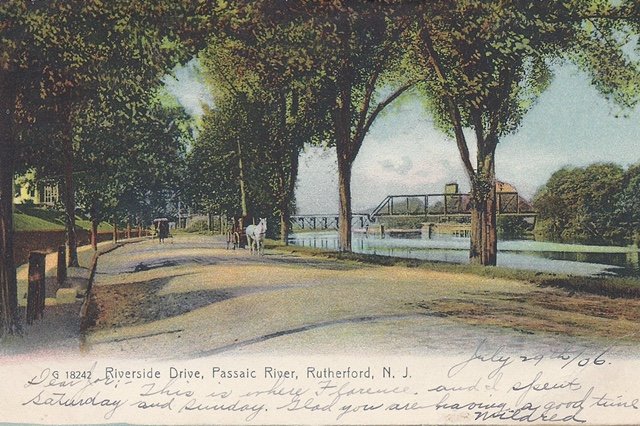Rutherford Historic Preservation Society
Rutherford Historic Preservation Society
Archives
February 2023
Major General Gershom Mott: A True Jerseyman
When the Union Veteran of the American Civil War, in Rutherford, NJ, decided to form a post of the Grand Army of the Republic, the membership voted on a name for the new post. This became General Gershom Mott Post #03, GAR.
Who was General Mott and why was he chosen to be the namesake of the post that was formed by these valiant men who fought to save the Union and end slavery?
Gershom Mott was born on April 7, 1822, in Lamberton, NJ. His grandfather was Captain John Mott, who guided General Washington’s Army to attack and win the Battle of Trenton. At the age of fourteen, he became a sales clerk in a store in New York City.
With the outbreak of the Mexican-American War, he was commissioned a second lieutenant, in the 1oth US Infantry. After the war, he returned to Lamberton and married Elizabeth Smith. They would have one daughter, named Kate.
From 1849 until 1861, Gershom held a number of jobs. This included a collector of the Port of Lamberton, an officer of the Bordertown Bank, and the Delaware &Raritan Company.
In the summer of 1861, with the opening of hostilities of the Civil War, Mott was appointed Lieutenant Colonel of the 5th New Jersey Volunteer Infantry. The 5th New Jersey fought in the Pennsylvania campaign and after the Battle of Williamsburg, he was promoted to Colonel and given command of the 6th New Jersey Volunteer Infantry.
He was commended for bravery in the Battle of Seven Pines. However, during the second battle of Bull Run, he was severely wounded in the arm. Sitting out the Battles of Antietam and Fredericksburg. Mott would return to the Army of the Potomac and get a brevet promotion to Brigadier General for bravery. He was given a command of a Brigade.
Leading his Brigade from the front, at the Battle of Chancellorsville, he was again seriously wounded. Mott would return to lead his Brigade in the Bristoe and Mine Run Campaigns. He now commanded the First Division, III Corps. However, with the dissolution of the III Corps, he reverted to command of a Brigade.
He was restored to Division Command (3rd Division II Corps) in July of 1864. His Division would take part in the Siege of Petersburg. During the disastrous Battle of the Crater, Mott was commended for his actions and given a brevet promotion to Major General.
Three days before the Confederate surrender at Appomattox, General Mott was wounded for a third time. He was promoted to full Major General, Effective May 26, 1865.
After the war, he was offered a commission as Colonel in the regular army. He declined and returned to New Jersey.
In 1866, he was made Paymaster of the Camden & Amboy Railroad. He would later go on to serve the State of New Jersey in a number of offices. On February 27, 1873, Gershom Mott was appointed Major General, commanding the New Jersey National Guard. On September 1st, 1875, he was appointed State Treasurer. His final service to the State of New Jersey would be as warden of the state prison.
Gershom Mott passed away on November 29, 1884 (age 62), and was given a full military funeral at Riverview Cemetery, Trenton, NJ.
Major General Gershom Mott Post #93, GAR, was founded in 1891. They met at the Firemen’s Hall on Ames Avenue, Rutherford. At one time they had a membership of 54 Union Civil War Veterans.
By James J. Halloran
January 2023
The ridge above the New Jersey Meadowlands upon which Rutherford sits was settled by Lenape Native Americans long before the arrival of Walling Van Winkle in 1687. Union Avenue, which runs from the Meadowlands to the Passaic River, may have been an Indian trail, but was more likely a property boundary line; it was referenced in the 1668 grant of land by proprietary Governor Philip Carteret to John Berry.
During the early days of settlement, the land that is now Rutherford was part of New Barbadoes Township, as Berry had lived in Barbados, another English colony, before claiming his grant in New Jersey. New Barbadoes was part of Essex County from 1693 to 1710, when Bergen County was formed. In 1826, the land became part of Lodi Township (of which today's remaining portion is now South Hackensack). When Hudson County was formed in 1840, the area that is today North Arlington, Lyndhurst, Rutherford and East Rutherford became part of Harrison Township (of which today's remaining portion is Harrison town). However, the area reverted to Bergen County in 1852 and became known as Union Township.
Part of the region was known as Boiling Springs for a powerful and ceaseless spring located in the vicinity. Despite its name, the spring actually consisted of cold groundwater seeps rather than hot springs.
The Erie Railroad built its Main Line from Jersey City across the Meadowlands in the 1840s. Daniel Van Winkle, a descendant of Walling, donated land in 1866 for a train station at Boiling Springs. Several resorts were built along the Passaic, with guests disembarking at Boiling Springs station and taking Union Avenue to the river. Later, the railroad opened a station closer to the river, at Carlton Hill, and a horsecar line (briefly on rails) along Jackson Ave took travelers to the resort area.
At the time, much of the property in Rutherford was farmland owned by the estate of John Rutherfurd, a former New Jersey legislator and U.S. Senator, whose homestead was along the Passaic River, near present-day Rutherford Avenue. Van Winkle opened a real estate office at Depot Square (now Station Square) to sell the land of the Rutherfurd Park Association, and began to lay out the area's street grid. The main roads were Orient Way, a wide boulevard heading south-southwest from Station Square, and Park Avenue, which headed west-southwest from Station Square to bring traffic to the new Valley Brook Race Course in what is now Lyndhurst.
In the 1870s, the area began to be called "Rutherford". The definitive reason for the change in spelling of the final syllable from "furd" to "ford" is unknown, though the change may have been the result of name recognition of the Ohio politician Rutherford B. Hayes, who was elected President in 1876, or could have been because of a clerical error by the United States Postal Service. The Post Office opened a facility called "Rutherford" in 1876. On September 21, 1881, the Borough of Rutherford was formed by formal vote of secession from Union Township. By then, the community had about 1,000 residents.







